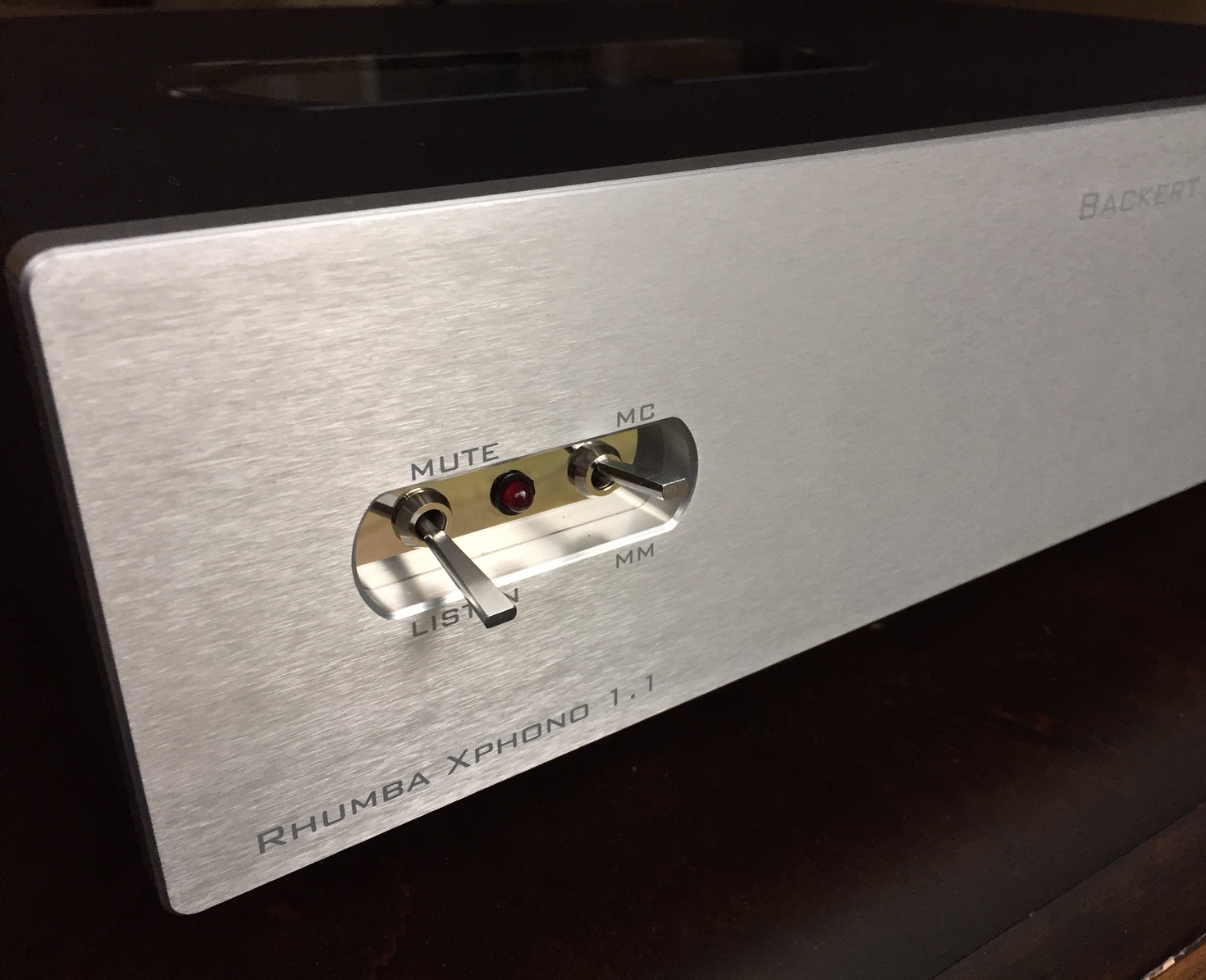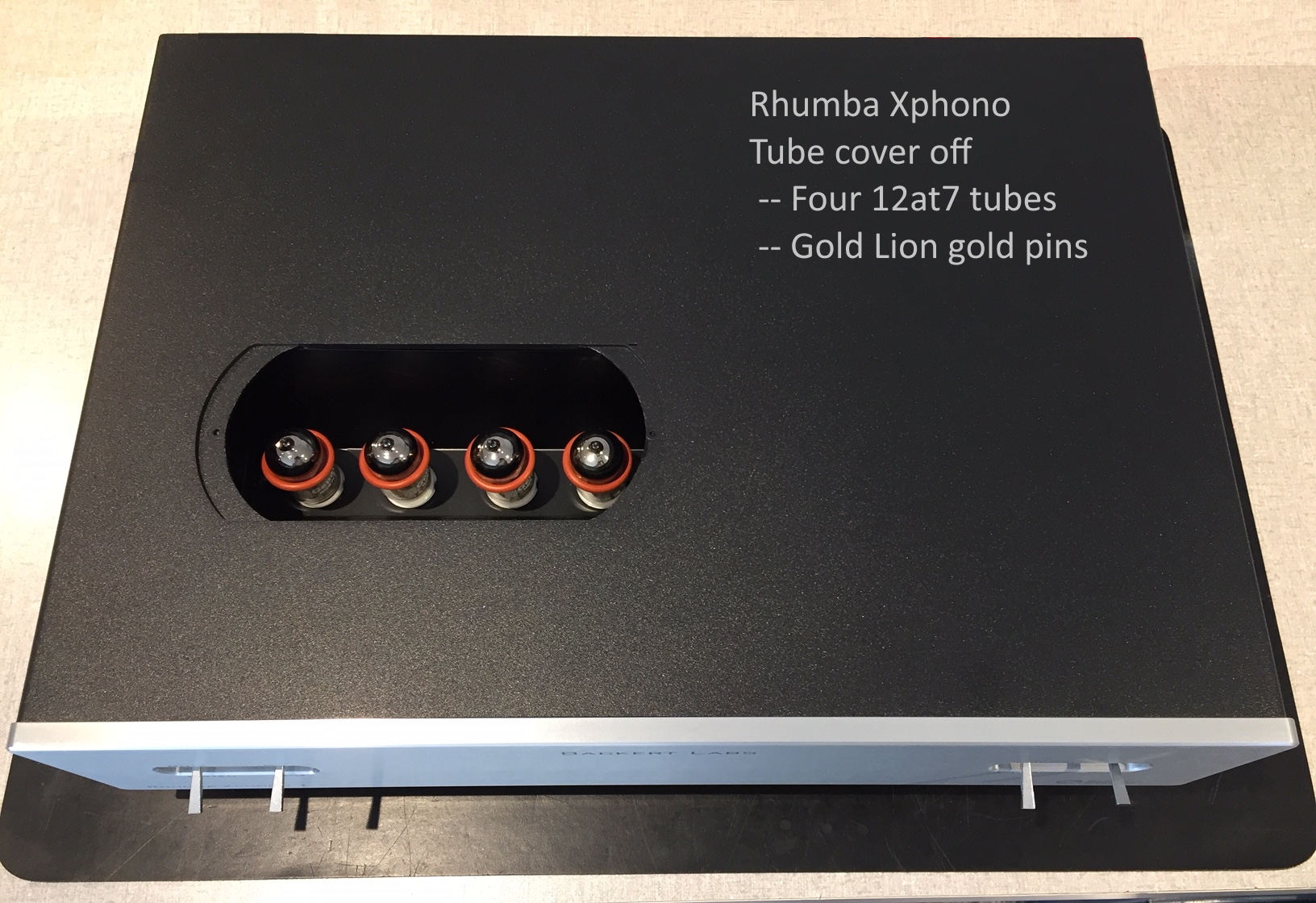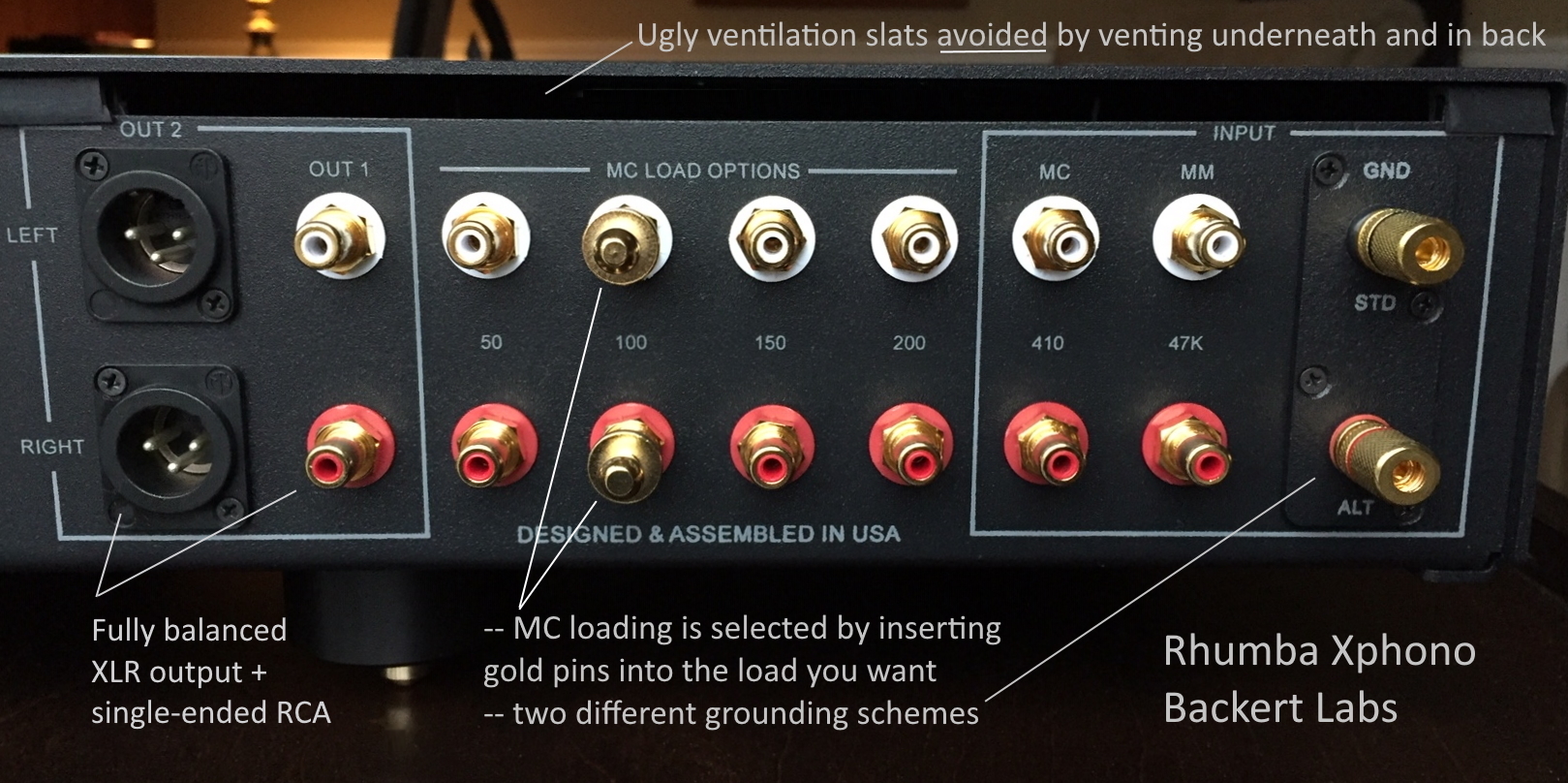|
Backert Labs
Xphono tube MM / MC phono pre-amp
Model 1.1

- MM and MC inputs, via separate RCA input pairs
- MM/MC switch on front panel
- Gain switch on front panel gives easy access to 2 different levels of gain for both MM and MC
- MC: 67 dB, or 61 dB
- MM: 47 dB, or 41 dB
- Fully balanced XLR output and traditional single-ended RCA output
- Backert Labs’ famous auto bias for all four 12at7 tubes
- GreenForce power supply
- Gold Lion “gold pin” 12at7 tubes
- Easy tube access with our tube door on the top panel
- Mute switch on front panel
- 15 different load options for MC
- Changing MC load is very easy: just plug in the supplied RCA plugs on the back panel
- 2 MC cartridges can be used at the same time, by feeding one into a step-up transformer leading to the MM input
- Two different grounding options for the ground wire coming from your turntable — “chassis ground” and “power supply ground” — try both and select the option that is most quiet
- Solid brass feet, the same ones found on our Rhumba Extreme linestage.
We have always loved our LPs.
When we come home to our records, we want exhilaration. Intimacy. A compelling, natural, moving experience. Spooky, even. Boring sound simply will not do.
We knew we could get more from our vinyl. So we invented a phono preamp that works in a new way, to produce the emotional beauty we crave. It’s called the Rhumba Xphono. It’s $7,000, and it’s going to change what you hear from your records.
That Feeling.
Bob Backert started the design of our phono preamp with GreenForce, his patented power supply. It’s more nimble than other power supplies. As a result, it propels a “happening-right-now” performance into your listening room. He could have stopped here: pairing his power supply with a normal, competent gain stage would have resulted in a significant advance in phono reproduction.
But instead he added the tubed amplification circuit from our award-winning Rhythm linestage preamp. Big. Dynamic. Rhythmic. And faithful to the precise tone created by the performers on your favorite recordings. But he still wasn’t finished.
Easy.
We make owning a tube preamp easy. Maybe you love tubes. Or, maybe you’ve never held a tube in your hand. Either way, it’s OK. The Rhumba Xphono uses four of them, all 12at7, and Bob Backert designed it so you won’t need to think about them much. This is because the Rhumba Xphono babies its tubes. Bob runs them so gently, they might just last forever. Of course, you can easily replace the tubes if you want to see how another brand sounds. By the way, the brand we use (Gold Lion, gold pin) sounds exceptionally good.
If you decide to experiment with different brands of tubes, the 12at7 type is very popular, plentiful, and affordable. And our handy tube door on top makes changing tubes as quick and easy as changing a light bulb.
The Phono Preamp Problem.
After putting these elements together, Bob Backert went a step further. He decided to tackle the phono preamp problem that nobody talks about. First, some background: a phono preamp isn’t just one amplifier. The music signal from your records travels through at least two stereo amplifiers in a phono preamp. One immediately following the other. That’s true whether your cartridge is MM, or MC.
Phono preamps have to be built like this, otherwise, the music signal wouldn’t be amplified enough.
The problem: manufacturers make these two amplifiers share the same power supply.
That’s especially unfortunate in a phono preamp. You see, while every amplifier wants a clean, steady power supply, the fact is, every amplifier “tugs” on its power supply as it amplifies music. So, the power supply is constantly disrupted. Meaning, the power coming to the amplifier is never 100% pristine and steady. Power supplies have regulators that attempt to fix this, but they aren’t perfect, and so the fact remains: amplifiers disrupt the very power that feeds them.
So if an amplifier shares its power supply with another amplifier, then the power for both amplifiers is doubly disrupted. Again, this sharing happens in every phono preamp on the market. But the problem is worse than you might expect. In a phono preamp, the first amplifier handles the very tiny signal coming straight from your cartridge. We’ll call this tiny music signal Tinkerbell. After she passes through the first amplifier in the phono preamp, she’s grown much larger — dozens of times larger. That larger music signal is then sent to the second amplifier, and again gets amplified to become dozens of times larger. Compared to Tinkerbell, the music signal in the second amplifier is like King Kong.
When you think about the tugging and disruption that every amplifier inflicts on its power supply, it becomes clear: for the Tinkerbell music signal in the first amplifier, sharing her power source with King Kong over in the second amplifier is bad news. Tinkerbell’s power source is constantly disrupted by her, AND by the King Kong music signal, which is a massively larger demand on the power supply. Therefore, a much larger disrupter of the power supply. As a result, Tinkerbell has no hope of getting pure, steady power for the tiny requests she is making to the power supply.
So in summary, the two amplifiers in every phono preamp are always disrupting their own power, and the power for the other amplifier, since the two amplifiers share the same power supply. And the first amplifier, handling the smallest music signal, is getting a particularly raw deal.
Some phono preamps have “dual mono” power supplies – does that fix this problem? No. Dual-mono means “separate power supplies for the left and right channels.” But each channel still has the two amplifiers we have been talking about, and they share the same power supply, even in dual-mono power supplies. Dual-mono power supplies are nice, but they don’t address the Tinkerbell/King Kong problem.
Does this problem affect both MM and MC cartridges?
Yes. A moving-magnet cartridge gets its signal amplified by two amplifiers in a row. A moving-coil cartridge has its signal sent through the exact same amplifiers, plus a third amplifier that we haven’t talked about.
Either way, the music from your cartridge is going through two amplifiers in a row, which are being forced to share a single power supply.
How we fixed the problem.
To deal with this issue, in the Rhumba Xphono, Bob Backert uses a separate, dedicated power supply for each amplifier. Or as an engineer would say it: a separate power supply for each gain stage.
So, in the Rhumba Xphono, the Tinkerbell and King Kong amplifiers each get their very own dedicated GreenForce power supply. What about the third amplifier, for MC cartridges? In the Rhumba Xphono, that’s a passive amplifier — a step-up transformer, which doesn’t use a power supply.
As a result of the Backert Labs approach, both stereo amplifiers in the Rhumba Xphono receive cleaner and more steady power. This produces more natural, more accurate and more life-like music.
It’s very new, and it’s very different. It’s a phono preamp that sounds like a Backert Labs.
More goodies.
As is the case with all of our preamps, the Rhumba Xphono:
- is designed and built by Bob and Gary Backert in Pennsylvania
- includes our famous tube cover, giving you instant access to the four 12at7 tubes
- uses our proprietary gain stage for the highest resolution sound
- is a pure Class A design
- uses no feedback — neither global, nor local
- has a custom-designed toroidal power transformer
- features a beautiful hi-tech exterior with no screws, no fasteners and no ventilation holes visible anywhere
- has all the other goodies that come with a Backert Labs preamp.


|



